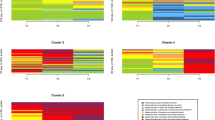Abstract
This article provides a brief history of the development of the federal model of school threat assessment, which was created by the U.S. Secret Service and U.S. Department of Education based upon findings from their empirical research on school shootings across the USA. The article reviews the major findings from that behavioral research, which demonstrates how it is possible to prevent school shootings and other targeted violence in school. The article also describes the components of this evidenced-based federal model and implementation guidance for schools and districts within the USA as well as other countries. The article concludes with the lessons learned by the authors and their colleagues in using the federal school threat assessment model to handle individual school threat cases and in training tens of thousands of other school, law enforcement, and mental health professionals how to use threat assessment to prevent school violence.
Similar content being viewed by others
References
Alathari, L. (2018). Written testimony of USSS national threat assessment center protective intelligence & assessment division chief Lina Alathari for senate committee on the judiciary. Hearing titled “See something, Say something: Oversight of the parkland shooting and legislative proposals to improve school safety.” Available at https://www.dhs.gov/news/2018/03/14/written-testimony-usss-senate-committee-judiciary-hearing-titled-see-something-say
Borum, R., Fein, R., Vossekuil, B., & Berglund, J. (1999). Threat assessment: defining an approach for evaluating risk of targeted violence. Behavioral Sciences & the Law, 17, 323–337.
Butterfield, F. & McFadden, R. (2001). 3 teenagers held in plot at Massachusetts school. The New York Times. Retrieved online on October 16, 2011 at http://www.nytimes.com/2001/11/26/us/3-teenagers-held-in-plot-at-massachusetts-school.html.
Cornell, D., Gregory, A. & Fan, X. (2011). Reductions in long-term suspensions following adoption of the Virginia Student Threat Assessment Guidelines. NASSP Bulletin, 45. Retrieved online on October 16, 2011 at http://bul.sagepub.com/content/early/2011/08/25/0192636511415255.
Deisinger, G., Randazzo, M., O’Neill, D., & Savage, J. (2008). The handbook for campus threat assessment & management teams. Carlsbad: TSG Solutions, Inc..
Fein, R., & Vossekuil, B. (1998). Protective intelligence and threat assessment investigations: a guide for state and local law enforcement officials. Washington, DC: U.S. Department of Justice, Office of Justice Programs, National Institute of Justice.
Fein, R., Vossekuil, B., & Holden, G. (1995). Threat assessment: An approach to prevent targeted violence. National Institute of Justice: Research in Action. Washington DC: U.S. Department of Justice, Office of Justice Programs.
Fein, R., Vossekuil, B., Pollack, W., Borum, R., Modzeleski, W., & Reddy, M. (2002). Threat assessment in schools: a guide to managing threatening situations and to creating safe school climates. Washington, DC: U.S. Department of Education and U.S. Secret Service.
Gray, R. (2009). Columbine 10 years later: the state of school safety today. Campus Safety Magazine. Retrieved on October 19, 2011 at http://www.campussafetymagazine.com/Channel/School-Safety/Articles/2009/03/Columbine-10-Years-Later-The-State-of-School-Safety-Today.aspx.
Kohn, D. (2009). To stop a massacre. 60 Minutes. Retrieved on October 16, 2011 at http://www.cbsnews.com/stories/2002/05/15/60II/main509196.shtml.
Meloy, J. R., Hoffman, J., Guldimann, A., & James, D. (2011). The role of warning behaviors in threat assessment: an exploration and suggested typology. Behavioral Sciences and the Law. https://doi.org/10.1002/bsl.999 Available online at www.wileyonlinelibrary.com. Retrieved August 25, 2011.
Nadeem, E., Jaycox, L., Langley, A., Wong, M., Kataoka, S., & Stein, B. (2014). Effects of trauma on students: early intervention through the Cognitive Behavioral Intervention for Trauma in Schools. In M. D. Weist, N. A. Lever, C. P. Bradshaw, & J. S. Owens (Eds.), Handbook of school mental health: research, training, practice, and policy: issues in clinical child psychology (Second ed.). New York: Springer.
Randazzo, M. R., & Cameron, J. K. (2012). From presidential protection to campus security: a brief history of threat assessment in North American schools and colleges. Journal of College Student Psychotherapy, 26(4), 277–290.
Randazzo, M., & Plummer, E. (2009). Implementing behavioral threat assessment on campus: a Virginia Tech demonstration project. Blacksburg: Virginia Tech University Press.
Randazzo, M. R., Borum, R., Vossekuil, B., Fein, R., Modzeleski, W., & Pollack, W. (2006). Threat assessment in schools: empirical support and comparison with other approaches. In S. R. Jimerson & M. J. Furlong (Eds.), The handbook of school violence and school safety: from research to practice. Mahwah: Lawrence Erlbaum Associates, Inc..
Reddy, M., Borum, R., Vossekuil, B., Fein, R., Berglund, J., & Modzeleski, W. (2001). Evaluating risk for targeted violence in schools: comparing risk assessment, threat assessment, and other approaches. Psychology in the Schools, 38, 157–172.
U.S. Department of Education, U.S. Department of Health and Human Services, U.S. Department of Homeland Security, U.S. Department of Justice, Federal Bureau of Investigation & Federal Emergency Management Agency. (2013). Guide for developing high-quality school emergency operations plans. Washington, DC: Authors.
Vossekuil, B., Fein, R., Reddy, M., Borum, R., & Modzeleski, W. (2002). The final report and findings of the safe school initiative: implications for the prevention of school attacks in the United States. Washington, DC: U.S. Department of Education and U.S. Secret Service.
Author information
Authors and Affiliations
Corresponding author
Ethics declarations
Ethical Approval
This article does not contain any studies with human participants or animals performed by any of the authors.
Conflict of Interest
Author William Modzeleski has received honoraria for presentations on school threat assessment. Author Marisa Randazzo co-owns a company that provides consulting and training services on threat assessment for schools, colleges, workplaces, and others. Authors Modzeleski and Randazzo also provide pro bono school threat assessment consulting and training services.
Rights and permissions
About this article
Cite this article
Modzeleski, W., Randazzo, M.R. School Threat Assessment in the USA: Lessons Learned from 15 Years of Teaching and Using the Federal Model to Prevent School Shootings. Contemp School Psychol 22, 109–115 (2018). https://doi.org/10.1007/s40688-018-0188-8
Published:
Issue Date:
DOI: https://doi.org/10.1007/s40688-018-0188-8




